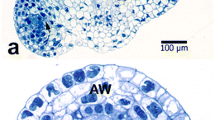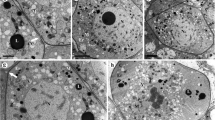Abstract
In this article, we studied the pollen morphology and wall development, microsporogenesis, male gametophyte development, and anther wall structure changes during pollen development of Cardiocrinum giganteum (Wall.) Makina from the genus Cardiocrinum (Endl.) Lindl. (Liliaceae) using paraffin sections, scanning and transmission electron microscopy, and fluorescence microscopy. The results showed that C. giganteum has oval-shaped pollen with a single sulcus and reticulate ornamentation. The exine is of the semi-tectum type and can be divided into the tectum layer, columellate layer and basal layer. Meiosis in the microsporocyte is accompanied by successive cytokinesis. The mature pollen is three-celled. The anther wall prior to maturity is built by one layer of epidermis, 1–2 layers of endothecium cells, 4–5 middle layers and 2 layers of tapetum, while upon maturity it is only built by one layer of epidermis, one layer of endothecium cells and one middle layer. The tapetal cells are secretory, with two or more nuclei. Ubisch bodies originate from rough endoplasmic reticulum except a few from mitochondria.




Similar content being viewed by others
References
Blackmore S, Crane PR (1988) The systematic implications of pollen and spore ontogeny. In: Humphries CJ (ed) Ontogeny and systematics. Columbia University Press, New York, pp 83–115
Buxbaum F (1937) Die Entwicklungslinien der Lilioideae II. Bot Archiv Band 38:213–398
Chen ZK, Wang FX, Zhou F (1988a) The ultrastructural aspect of tapetum and Ubisch bodies in Anemarrhena asphodeloides. Acta Bot Sin 30(1):1–5
Chen ZK, Wang FX, Zhou F (1988b) On the origin, development and ultrastructure of the orbicles and pollenkitt in the tapetum of Anemarrhena asphodeloides (Liliaceae). Grana 27:273–282
Chen ZK, Zhou F, Wang FX (1988c) Investigation on the development of male gametophyte in Anemarrhena asphodeloides. Acta Bot Sin 30(6):569–573
Clément C, Audran JC (1993a) Cytochemical and ultrastructural evolution of orbicules in Lilium. Plant Syst Evol 7:63–74
Clément C, Audran JC (1993b) Orbicule wall surface characteristics in Lilium (Liliaceae). Grana 32:348–353
Clément C, Pacini E (2001) Anther plastids in angiosperms. Bot Rev 67:54–73
Doyle JA (2005) Early evolution of angiosperm pollen as inferred from molecular and morphological phylogenetic analyses. Grana 44:227–251
Endlicher SL (1947) Genera plantarum. J Arnold Arb 28:424
Furness CA, Rudall PJ (1999) Microsporogenesis in monocotyledons. Ann Bot 84:475–499
Herich R, Lux A (1985) Lytic activity of ubisch bodies (orbicles). Cytologia 50:563–569
Heslop Harrison J (1962) Origin of exine. Nature 195:1069–1071
Hu SY (2005) Reproductive biology of angiosperms. Higher Education Press, Beijing
Huysmans S, El-Ghazaly G, Smets E (1998) Orbicules in angiosperms: morphology, function, distribution, and relation with tapetum types. Bot Rev 64:240–272
Knox B, Suphioglu C (1996) Environmental and molecular biology of pollen allergens. Elsevier Trends J l 5:156–164
Kosenko VN (1999) Contributions to the pollen morphology and taxonomy of the Liliaceae. Grana 38:20–30
Li ZL (1978) The technology of Making Sections in plant tissues. Science Press, Beijing, pp 129–137
Liang SY (1995) Chorology of Liliaceae (s.str.) and its bearing on the Chinese flora. Acta Phytotaxonomica Sinica 33(1):27–51
Liang HZ, Zhang XL (1984) The microsporogenesis and formation of male-gametophyte of two species in Paris L. Acta Bot Yunnan 6(4):435–440
Liu JX, Zhang J, Liu HJ et al (2011) Anther structure and pollen ontogeny of Hosta Tratt. and its systematic significance. Plant Syst Evol 297:253–260
Luo CH, Wang SF (1991) The karyotype analysis and study of meiosis for Cardiocrinum giganteum (Wall.). Makino. J Southwest Teachers University 16(1):113–116
Matthews VA (2002) The genus Cardiocrinum in cultivation. The Plantsman 1(4):196, 198, 200–201, 203–205
Nair PKK, Sharma M (1965) Pollen morphology of Liliaceae. J Palyno 1:38–61
Rao GY, Pan KY, Hong DY (1995) Embryological studies on Convallaria majalis L. Acta Bot Sinica 37(12):963–968
Rosanoff S (1865) Zur Kenntniss des Baues und der Entwickelungsgeschichte des Pollens der Mimosaceae. Jahrb Wiss Bot 4:441–450
Shen JH, Shen Y, Wang YJ et al (2006) Megasporogenesis, microsporogenesis and development of female and male gametophyte of Hemerocallis citrine Baroni. Acta Horticulturae Sinica 33(1):38–45
Walker JM (1974) Aperture evolution in the pollen of primitive Angiosperms. Amer Jour Bot 61(10):1112–1136
Wang FZ, Tang J (1980) Flora of China. Science Press, Beijing, vol 14 pp 65–166
Wang CS, Walling LL, Eckard KJ et al (1992a) Immunological characterization of a tapetal protein in developing anthers of Lilium longiflorum. Plant Physiol 99:822–829
Wang CS, Walling LL, Eckard KJ et al (1992b) Patterns of protein accumulation in developing anthers of Lilium longiflorum correlate with histological events. Amer J Bot 79(2):118–127
Wang M, Wan L, Chen HN et al (2012) A new fluorescent staining method for callose of microspore mother cells during meiosis. Biotech Histochem 87(4):300–302
Woodcock HBD, Stearn WT (1950) Lilios of the world. London Country Life Limited, London
Xi XY (1991) A comparative study of anther and pollen development in male-fertile and male-sterile green onion (Allium fistulosum L.). Acta Bot Sinica 33(10):770–775
Yuan T, Lu WS, Cao H et al (1999) Study on the embryo of Allium sativum I. the development of stamen and the genesis of microspore. Henan Sci 17:10–15
Zhao H, Yang PJ (2002) Microsporogenesis and male-gametogenesis of Hosta plantaginea Aschers. J Hanzhong Teachers College (Natural Science) 20(2):77–81
Acknowledgments
This work was supported by the National Natural Science Foundation of China (grant no. 30470106) and the Beijing Natural Science Foundation of China (grant no. 8102012).
Author information
Authors and Affiliations
Corresponding author
Rights and permissions
About this article
Cite this article
Chen, HN., Zhao, CH., Liu, XR. et al. Pollen development of Cardiocrinum giganteum (Wall.) Makina in China. Plant Syst Evol 298, 1557–1565 (2012). https://doi.org/10.1007/s00606-012-0658-9
Received:
Accepted:
Published:
Issue Date:
DOI: https://doi.org/10.1007/s00606-012-0658-9




